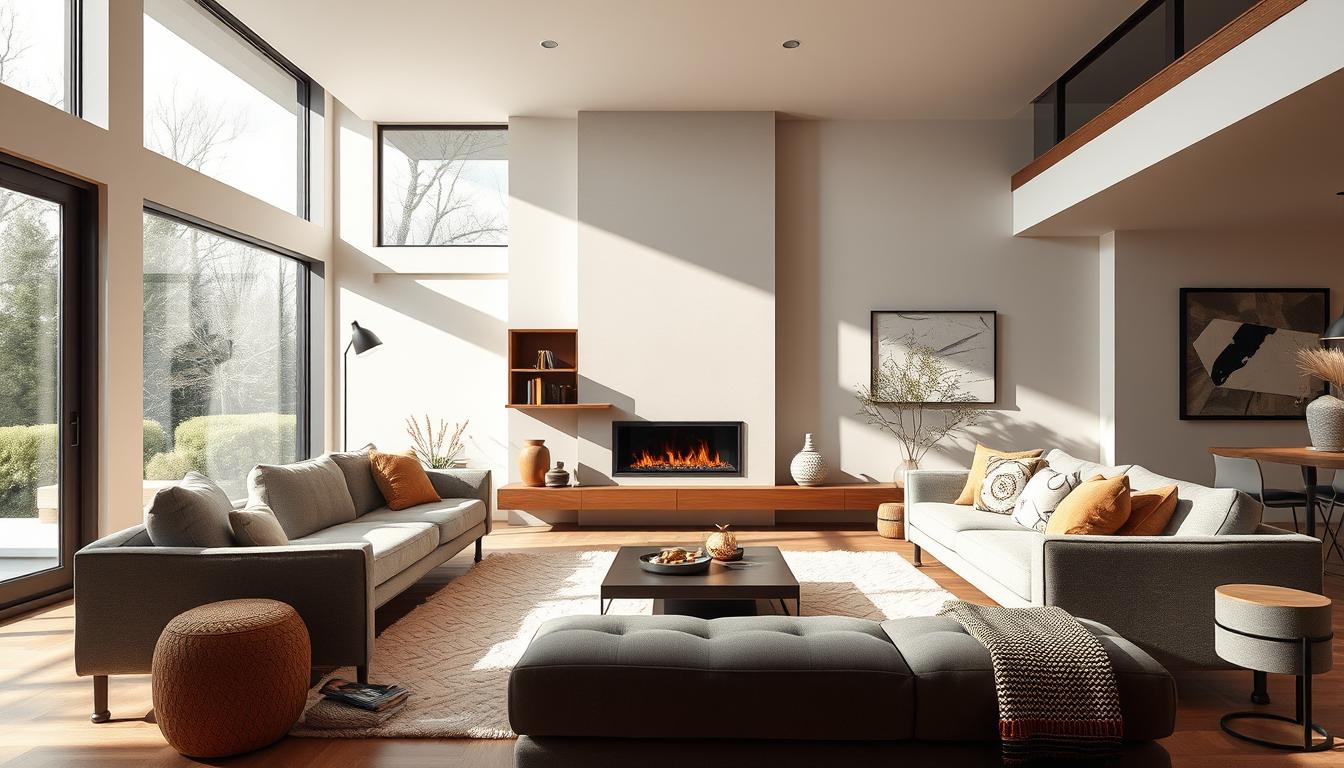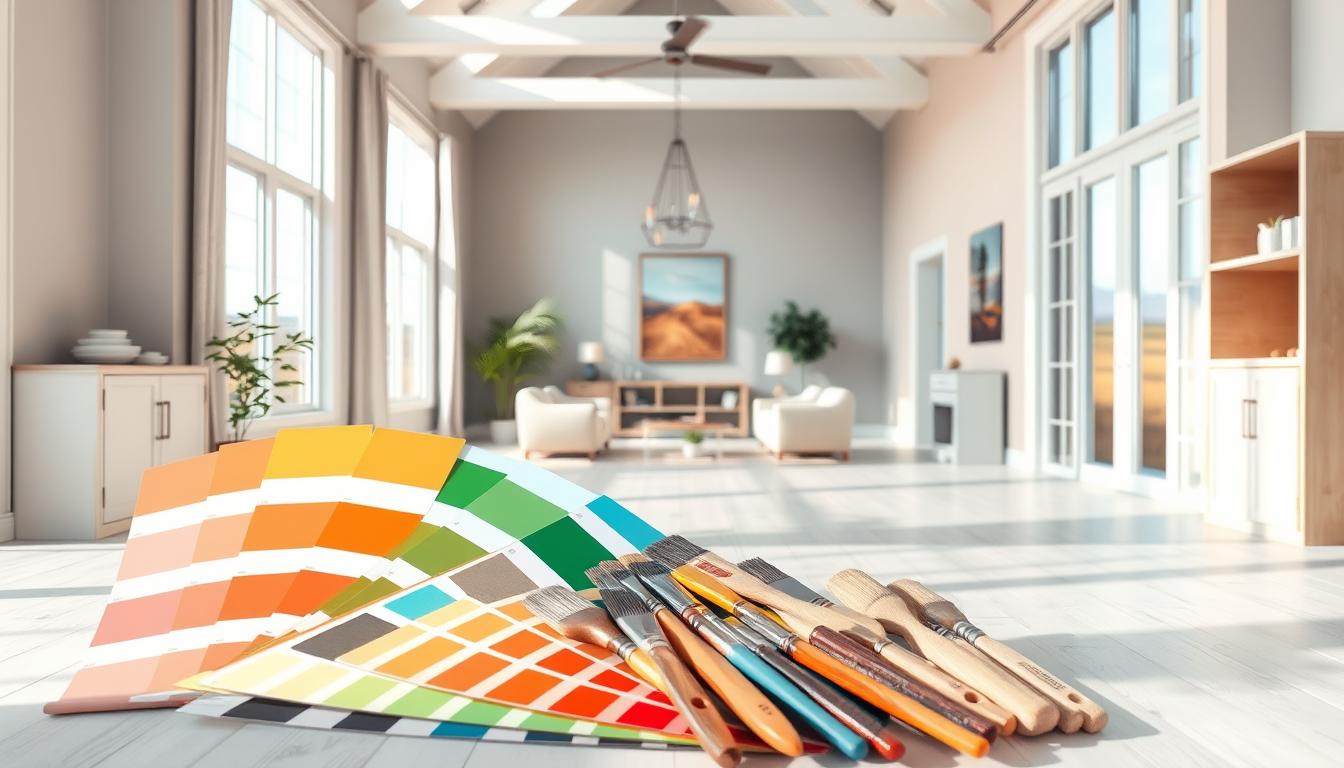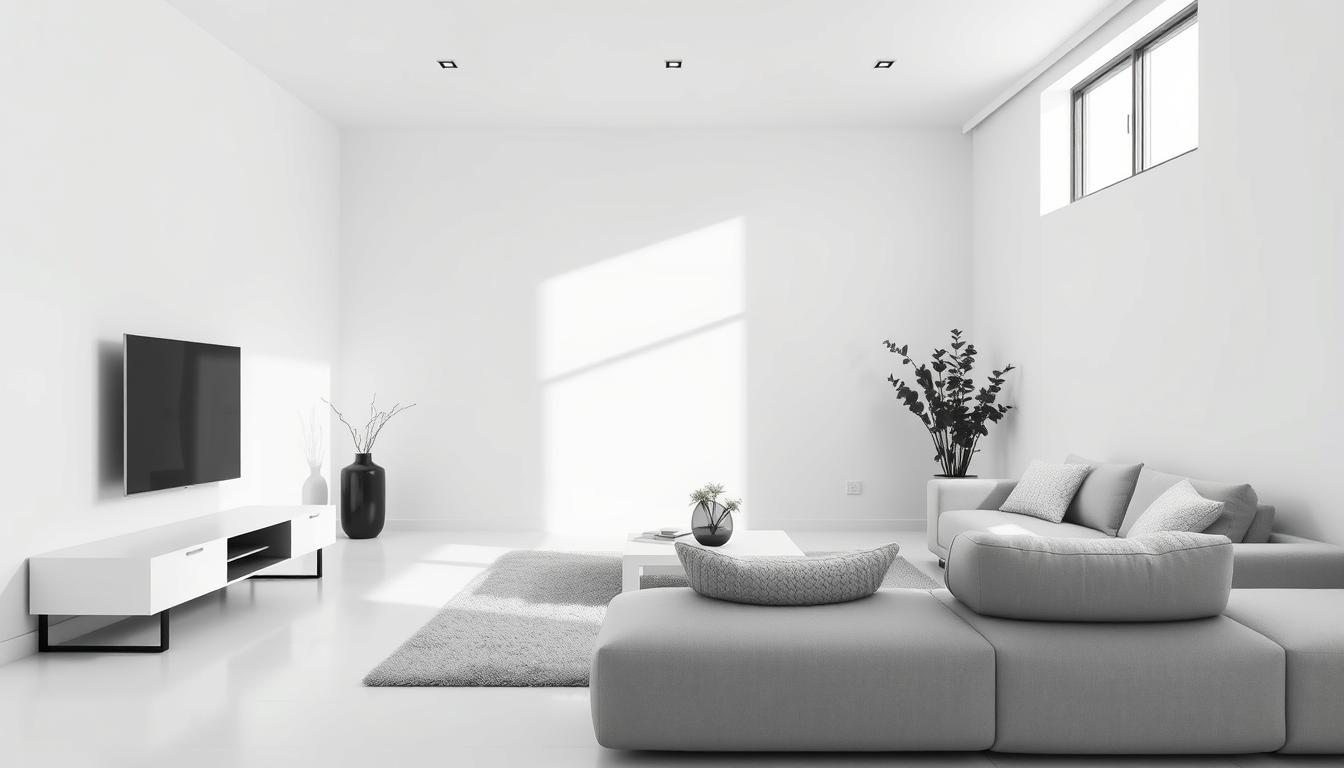Did you know the right interior design can boost your property value by up to 15%? With many modern interior design trends out there, picking the perfect style for your living space can feel daunting.
We know how crucial it is to create a harmonious and functional space that shows off your personality. In this article, we’ll dive into various interior home styles, from classic to contemporary. Our goal is to help you make a choice that’s right for you.
Key Takeaways
- Understand the different types of interior home styles
- Learn how to choose the best style for your space
- Discover the latest modern interior design trends
- Get tips on how to incorporate your personal style
- Explore the benefits of a well-designed interior space
Understanding Interior Home Styles
Interior home styles are more than looks; they show who we are. When we pick a style, we’re not just picking colors and furniture. We’re making a space that affects our mood and well-being.
Different styles change how our homes feel and work. From traditional home decor that feels cozy to contemporary house interiors that are modern and sleek, each style has its charm.
What Are Interior Home Styles?
Interior home styles are different design categories. They are defined by colors, furniture, textures, and decorations. These styles help homeowners and designers create beautiful spaces.
“The right interior design style can transform a house into a home, making it a reflection of the inhabitants’ tastes and values.”
Key elements of interior home styles include:
- Color schemes and palettes
- Furniture styles and selection
- Textures and materials used
- Decorative elements and accessories
| Style | Key Characteristics | Ambiance |
|---|---|---|
| Traditional | Classic furniture, rich colors, ornate details | Warm, inviting |
| Contemporary | Minimalist furniture, neutral colors, sleek lines | Modern, sleek |
Importance of Choosing the Right Style
Choosing the right style is key. It affects how our homes look and how we feel. A good style can make our homes more functional and improve our mood.
For example, a family with kids might choose a practical style. A city couple might go for something sleek to save space. Knowing about interior styles helps us decorate wisely.
Popular Interior Home Styles in the United States
The United States has many interior home styles, each with its own charm. These styles reflect the country’s rich culture. You’ll see what makes them special and how they show the country’s heritage.
Traditional Style
Traditional design is known for its classic beauty and timeless feel. It uses rich colors, detailed patterns, and cozy furniture. This style creates a warm, welcoming space.
Key Features of Traditional Style:
- Rich color palettes
- Ornate details and patterns
- Comfortable, plush furnishings
Modern Style
Modern design focuses on simplicity and clean lines. It’s about being functional and using the latest tech. If you like a clean, modern look, this style is great.
Characteristics of Modern Style:
- Minimalistic decor
- Clean lines and geometric shapes
- Integration of technology
Contemporary Style
Contemporary style is often mixed up with modern, but it’s about today’s trends. It’s dynamic and always changing. It’s perfect for a fresh, updated look.
To learn more about popular interior design styles, check out Architectural Digest. They have detailed articles and lots of inspiration.
Rustic Style
Rustic design loves natural materials like wood and stone. It uses earthy colors to create a cozy, welcoming space. It feels connected to nature.
Rustic Style Essentials:
| Material | Characteristics |
|---|---|
| Wood | Reclaimed, distressed, or natural finish |
| Stone | Used for fireplaces, walls, or flooring |
| Earth Tones | Colors like brown, green, and beige |
In conclusion, each style offers a unique look that can match your taste. Whether you like traditional elegance, modern simplicity, contemporary freshness, or rustic charm, there’s a style for everyone.
Elements That Define Each Style
To get a specific interior home style, knowing the key elements is crucial. Whether you love eclectic interior design, vintage home styles, or something else, these elements help you create a space that shows your personality.
Color Palettes
Color palettes set the mood of a home. Each style has its own color scheme. For example, vintage homes often use soft pastels and muted tones. Eclectic designs might have bold, contrasting colors.
Here are some color palettes for different styles:
| Style | Color Palette |
|---|---|
| Traditional | Warm neutrals, rich reds, and deep blues |
| Modern | Monochromatic schemes, bold brights, and metallic accents |
| Eclectic | Mixed bold colors, patterns, and textures |
Furniture Selection
Furniture choice is key in defining a home style. The style, era, and material of furniture greatly affect a room’s look. For example, vintage home styles often use antique furniture, while modern styles prefer sleek, minimalist pieces.
When picking furniture, think about the style you want. For a rustic look, choose furniture made from natural materials like wood or stone.
Textures and Materials
Textures and materials add depth and interest to a space. They are crucial in defining a style. For instance, a cozy, rustic style might use plush textiles and natural materials like wood or brick.
To achieve a cohesive look, mix different textures and materials. In an eclectic design, combine smooth surfaces with rough textures and metallic accents.
How to Blend Different Interior Styles
Blending interior styles is an art that can make your home truly unique. It lets you show off your personality through your home’s look. This way, your home stands out from the rest.
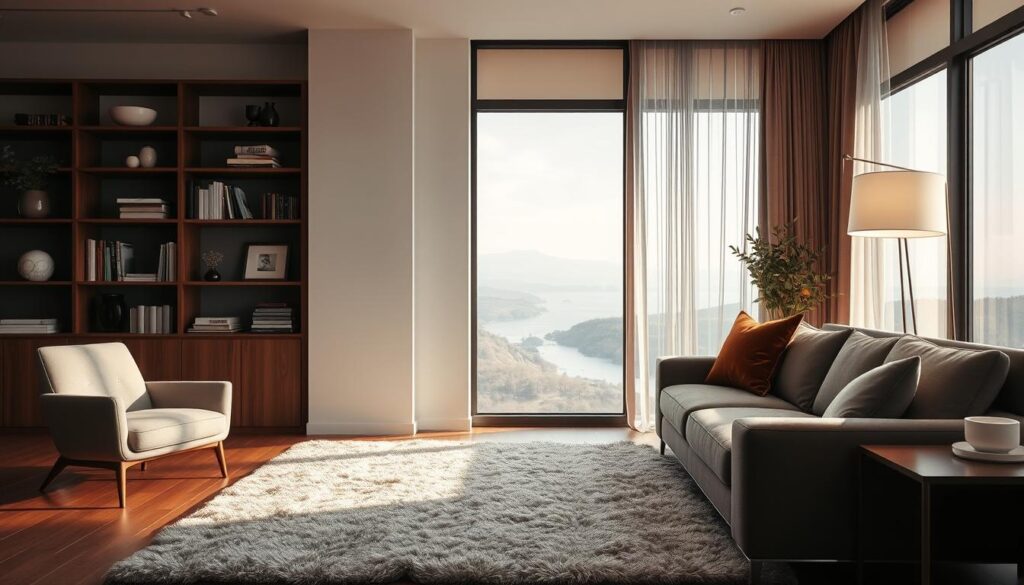
Tips for Eclectic Design
Eclectic design mixes different styles for a cohesive look. Start with a common thread, like a color or texture, to link everything together. For example, you can mix modern interior design with traditional home decor for a cool look.
Balance contrasting pieces to make your space interesting. Pair a bold, modern sofa with a classic armchair for a nice contrast. Remember, it’s all about having fun and trying new things.
Creating Harmonious Spaces
To blend styles harmoniously, start with a neutral base. Then, add color or texture with accessories. This way, you can mix styles without feeling overwhelmed.
For instance, a neutral wall can hold a mix of modern and traditional furniture. Add rugs, throw pillows, and art to bring it all together. This creates a space that feels cohesive and inviting.
Blending styles is about finding a balance that shows your taste. Follow these tips and trust your instincts. You’ll create a space that’s uniquely yours and welcoming.
Choosing a Style Based on Your Lifestyle
Our lifestyle greatly influences our choice of interior design style. It’s important to think about how we live, work, and relax at home.
Family Needs
Family needs are crucial when picking an interior design style. For example, families with young kids might prefer a rustic chic design. This style is warm and forgiving for spills and stains.
On the other hand, families with older kids or those who work from home might choose a contemporary house interiors style. This style is sleek and modern, perfect for productivity.
- Consider the age and needs of your family members.
- Think about the functionality required in your living spaces.
- Choose materials and finishes that are durable and easy to maintain.
Lifestyle Activities
Our home activities also shape our design choices. For instance, if you love to entertain, an open-plan living area is ideal. It encourages socializing.
If you’re a book lover, a cozy reading nook with comfy seating and good lighting is perfect.
Some key considerations include:
- Assessing how you use each room in your home.
- Identifying the activities that are most important to you.
- Designing spaces that support these activities.
Space Utilization
Effective space utilization is key to making the most of your home. It’s not just about furniture arrangement but also how the space is used. For smaller homes, a minimalist approach works well. Larger homes can handle more elaborate designs.
| Design Consideration | Small Space | Large Space |
|---|---|---|
| Furniture | Multi-functional | Statement pieces |
| Color Scheme | Light colors | Varied palette |
| Layout | Open plan | Defined areas |
By considering our lifestyle, family needs, and space use, we can pick a design style that’s both beautiful and functional. Whether you prefer a contemporary house interiors or a rustic chic design, the goal is to create a space that reflects your personality and supports your lifestyle.
Popular Color Trends in Interior Home Styles
Color trends are key in interior design, shaping our home’s feel. The right colors can make a space welcoming, modern, or cozy. We’ll look at the top color trends, from simple to eclectic designs.
Earthy Tones
Earthy tones are popular for their warmth and natural beauty. They include greens, terracotta, beige, and gray. These colors create a calm, organic feel, great for a peaceful home.
- Sage green for a soothing ambiance
- Terracotta for a warm, earthy feel
- Driftwood gray for a subtle, coastal vibe
Bold Colors
Bold colors add personality and energy to a room. Deep blues, emerald greens, and bright yellows make a statement. Used right, they bring depth and life to your home.
- Deep blues for a dramatic effect
- Emerald greens for a luxurious feel
- Vibrant yellows for a sunny disposition
Pastels
Pastel colors are soft and gentle, adding whimsy and elegance. They’re perfect for minimalist designs, creating a clean, airy feel. Pastels are ideal for modern homes.
Some popular pastel shades include:
- Soft pinks for a romantic ambiance
- Light lavenders for a calming effect
- Mint greens for a fresh, cool vibe
Choosing a color trend depends on personal taste and lifestyle. Whether you prefer earthy tones, bold colors, or pastels, there’s a trend for everyone.
Furniture Trends in Interior Design
Furniture trends in interior design are about more than looks. They’re about function and being green. The furniture we pick shapes our homes in big ways.
Multi-Functional Furniture
Multi-functional furniture has changed interior design. With smaller living spaces, we need furniture that does more. For example, a storage ottoman can be a seat and a place to store things. A murphy bed turns a living room into a bedroom.
Some top picks for multi-functional furniture are:
- Sofa beds
- Storage coffee tables
- Nesting tables
Sustainable Options
There’s a big push for eco-friendly furniture now. People want furniture that’s good for the planet. This means furniture made from wood that’s been saved, bamboo, and other green materials.
| Material | Sustainability Features | Examples |
|---|---|---|
| Reclaimed Wood | Reduces waste, preserves history | Wooden tables, shelving units |
| Bamboo | Fast-growing, renewable | Bamboo chairs, flooring |
| Recycled Metal | Reduces landfill waste, conserves resources | Metal lamps, decorative items |
Vintage vs. New
The choice between vintage and new furniture is a big trend. Vintage pieces have a special charm and history. New furniture brings modern looks and lasts longer. Many mix both for a look that’s both trendy and personal.
Vintage furniture has:
- Unique character
- Sustainability through reuse
- Potential for antique value
New furniture, on the other hand, offers:
- Modern designs and functionality
- Durability and less maintenance
- Customization options
Accessorizing Your Home: A Key Element
Accessorizing is key in interior design. It adds character and depth to a space. Accessories are not just extra items; they’re essential for a room’s look.
Importance of Accessories
Accessories are vital for completing a room’s look. They add personality, create a cohesive look, and set the mood. For example, traditional home decor uses vintage rugs and ornate lighting for warmth and elegance.
Contemporary house interiors use sleek, minimalist accessories for a clean, modern feel. Knowing the role of accessories is crucial for a well-designed space.
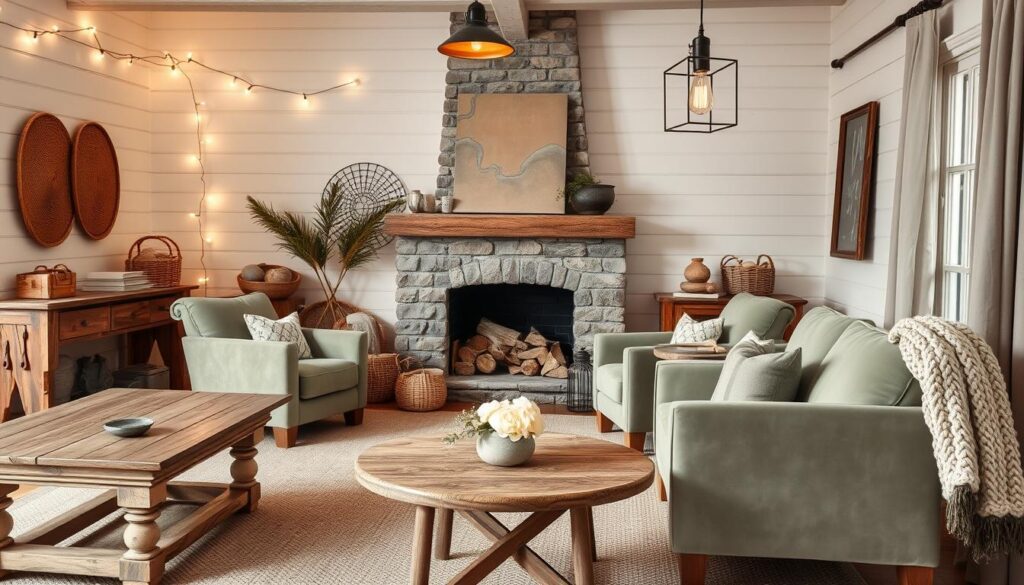
Finding the Right Decor
Finding the right decor involves several factors. Consider your home’s style, your preferences, and the items’ functionality. For a rustic chic design, look for natural materials, earthy tones, and vintage pieces.
- Choose decor that complements your color palette.
- Consider the texture and material of accessories for depth.
- Balance your decor to avoid clutter.
For more on interior design styles, check out Decorilla’s guide.
Layering Textiles
Layering textiles adds depth and interest to a room. It involves mixing textures, patterns, and colors for a cozy atmosphere. For instance, layering throw blankets, rugs, and decorative pillows can make a living room more inviting.
- Begin with a base layer, like a rug or sofa cover.
- Add a secondary layer with throw blankets or pillows.
- Finish with accent pieces like vintage scarves or embroidered linens.
Layering textiles creates a rich, dynamic look that shows your personal style.
Frequently Asked Questions About Interior Home Styles
Exploring interior home styles can raise many questions. It’s natural to feel overwhelmed by the different styles out there. But don’t worry, we’re here to clear up some common doubts.
Choosing the Right Style
Choosing the right style for your home depends on several things. Your personal taste, lifestyle, and home’s architecture are key. For a simple look, think about using neutral colors and keeping things tidy.
Mixing Different Styles
Mixing styles can create a unique and interesting look. To make it work, balance out different elements. For example, you could mix old and new furniture for a cool contrast.
Future Trends
The future of home design will focus on being green, using tech, and being personal. We’ll see new materials, smart homes, and designs that show off your unique style.

